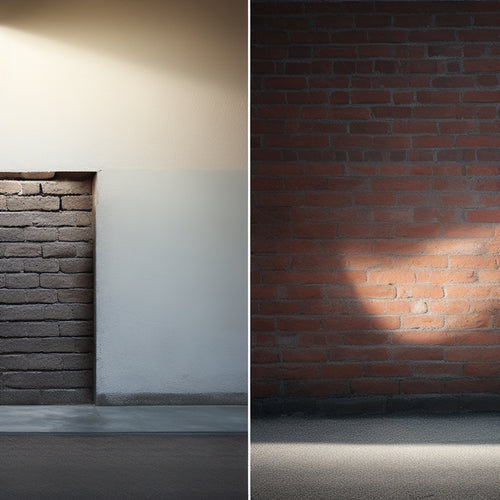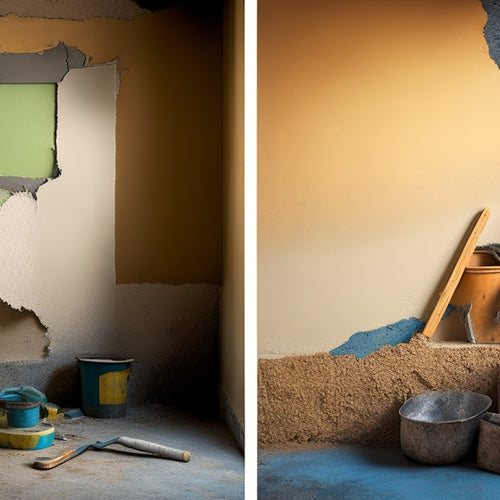
Top DIY Concrete Filling Kits for Home Renovation
Share
You'll find a wide range of DIY concrete filling kits on the market, each suited to tackle specific home renovation projects. Top-rated concrete crack fillers like SikaBond and Loctite PL Premium offer durability and versatility. Epoxy-based filling solutions provide exceptional bonding strength and resistance to chemicals and abrasion. Polyurethane foam injectors allow for precise control over foam expansion, while fast-drying concrete patching kits enable quick repairs. When choosing a kit, consider your project's specific needs, and don't forget to factor in budget-friendly and eco-friendly options. As you explore the world of DIY concrete filling, you'll uncover the best solutions for your next renovation project.
Key Takeaways
• Epoxy-based fillers offer exceptional bonding strength and durability, making them a popular choice for DIY concrete filling kits.
• Polyurethane foam injectors provide precise control over foam expansion, ensuring professional-grade results in DIY concrete repairs.
• Fast-drying concrete patching kits enable quick filling of cracks and holes, ideal for time-sensitive projects with minimal downtime.
• Budget-friendly options like polyurethane foam and epoxy-based fillers maintain quality while reducing costs, making them suitable for DIY projects.
• Proper surface preparation, including cleaning and drying, is crucial for successful concrete repairs, regardless of the filling material chosen.
Top-Rated Concrete Crack Fillers
When evaluating top-rated concrete crack fillers, you'll find that epoxy-based products, such as SikaBond Concrete Fix and Loctite PL Premium, consistently rank high regarding durability and versatility.
These products are designed to provide a strong, long-lasting bond between the concrete and the filler, making them ideal for crack prevention. To guarantee ideal results, proper surface preparation is vital. This includes cleaning the area thoroughly, removing any debris or dirt, and drying the surface completely.
By doing so, you'll create a strong bond between the filler and the concrete, reducing the likelihood of future cracks.
When choosing a concrete crack filler, consider the type of crack you're dealing with. For hairline cracks, a flowable filler may be sufficient. For larger cracks, a more viscous filler may be necessary.
Regardless of the type of crack, it's important to follow the manufacturer's instructions and take necessary safety precautions, such as wearing gloves and protective eyewear.
Best DIY Concrete Repair Kits
You can achieve professional-looking results with the right DIY concrete repair kit, which typically includes a specialized epoxy or polyurethane-based resin, a primer, and other accessories. These kits are designed to help you tackle various concrete repair tasks, from filling cracks and holes to resurfacing entire areas.
When selecting a DIY concrete repair kit, consider the type of repair you need to make and the condition of the concrete surface. Proper concrete surface preparation is essential for a successful repair. Make certain to clean and prepare the area before applying the filling material.
Filling material selection is also vital, as different materials have varying strengths, flexibilities, and adhesion properties. Look for kits that include a suitable primer to guarantee a strong bond between the old and new concrete. Additionally, consider the color and texture of the filling material to guarantee a seamless blend with the surrounding concrete.
Epoxy-Based Filling Solutions
Epoxy-based filling solutions are a popular choice for DIY concrete repair kits due to their exceptional bonding strength, durability, and resistance to chemicals and abrasion.
When you choose an epoxy-based filling solution, you can rest easy that the repaired area will withstand harsh conditions and last for a long time. The key to achieving a successful repair lies in the epoxy adhesion, which relies heavily on proper surface preparation.
You'll need to verify the concrete surface is clean, dry, and free of any contaminants that could compromise the bond. A thorough surface preparation will allow the epoxy to penetrate deep into the concrete, creating a strong and lasting bond.
To achieve excellent results, it's crucial to follow the manufacturer's instructions for surface preparation and application. This may involve etching the surface, applying a primer, or using a specialized cleaning solution.
Polyurethane Foam Injectors
When using polyurethane foam injectors, you'll need to carefully control the foam's expansion to avoid over- or under-filling the void.
This requires precise hole drilling to guarantee the foam is injected at the correct pressure and volume.
Foam Expansion Control
Polyurethane foam injectors, an indispensable component of foam expansion control systems, enable precise regulation of foam flow and pressure. When you're working with DIY concrete filling kits, you need to verify that the foam expands uniformly and doesn't over-pressurize the surrounding concrete. That's where foam expansion control comes in.
By using polyurethane foam injectors, you can achieve foam stability and prevent unwanted expansion. This is vital, as excessive foam expansion can lead to structural damage or even collapse.
You'll appreciate the level of control these injectors provide, allowing you to fine-tune the foam flow and pressure to match your specific project requirements. With precise regulation, you can verify that the foam fills the desired space without exerting excessive force.
This not only prevents damage to the surrounding concrete but also guarantees a more effective and lasting repair. By incorporating polyurethane foam injectors into your DIY concrete filling kit, you'll be able to achieve professional-grade results with confidence.
Precise Hole Drilling
Drilling precise holes is essential for effective polyurethane foam injection, as it enables you to target the exact areas where the foam needs to flow. To achieve this, you'll need to master hole alignment techniques and drill bit selection.
Here are three key considerations to keep in mind:
-
Drill bit selection: Choose a drill bit that's specifically designed for concrete, and guarantee it's the correct size for your injector. A bit that's too small can lead to poor foam flow, while one that's too large can cause the foam to escape.
-
Hole alignment techniques: Use a level and a straightedge to guarantee your holes are perfectly aligned. This will prevent the foam from flowing unevenly or escaping through gaps.
-
Drilling technique: Apply gentle, consistent pressure while drilling, and avoid applying too much pressure, which can cause the bit to slip or the concrete to crack.
Fast-Drying Concrete Patching
Filling cracks and holes in concrete structures quickly becomes a priority when time is of the essence, and that's where fast-drying concrete patching comes into play. You need a reliable solution that can withstand the test of time and harsh environmental conditions.
Fast-drying concrete patching kits are designed to help you achieve just that. These kits typically consist of fast-setting mixtures that harden rapidly, often within 15-30 minutes, depending on the product. This rapid hardening process allows you to apply multiple coats in a short span, saving you valuable time and effort.
When choosing a fast-drying concrete patching kit, look for products that incorporate shrinkage control additives. These additives help minimize the risk of cracks and shrinkage, ensuring a durable and long-lasting repair.
Budget-Friendly Filling Options
As you explore budget-friendly filling options for your DIY concrete filling kit, you'll find cost-effective solutions that won't break the bank.
You can opt for affordable filling alternatives that provide similar results without the hefty price tag.
Cost-Effective Solutions Found
What makes DIY concrete filling kits an attractive solution is that they often come with budget-friendly options that can help you save money without compromising on quality. As you're renovating your home, it's crucial to find cost-effective solutions that meet your needs. When it comes to concrete filling kits, you can find affordable options that still provide excellent results.
Here are three cost-effective solutions you can consider:
-
Eco-friendly kits: Look for kits that use sustainable materials, reducing your carbon footprint while saving you money. These kits are often made from recycled materials, making them an environmentally friendly choice.
-
Basic repair kits: If you're only dealing with minor cracks or holes, a basic repair kit can be a cost-effective solution. These kits usually include a small amount of filler and an applicator, perfect for small jobs.
-
Multi-use kits: Invest in a multi-use kit that can be used for various projects around the house. These kits often include a range of products, such as fillers, sealants, and adhesives, which can be used for different applications.
When choosing a budget-friendly option, be sure to read user reviews to verify you're getting a high-quality product that meets your needs. By doing so, you'll be able to find a cost-effective solution that saves you money without compromising on quality.
Affordable Filling Alternatives
You can explore alternative filling options that are gentle on your wallet, such as using polyurethane foam or epoxy-based fillers, which offer a cost-effective solution for minor concrete repairs. These budget-friendly alternatives can help you save money without compromising on quality.
When choosing an affordable filling kit, consider sustainable materials that are eco-friendly and reduce waste. Opt for products with minimal packaging, recyclable materials, and low VOC (volatile organic compound) emissions.
Another eco-friendly option is to repurpose materials you already have at home. For instance, you can mix sawdust with a binding agent like cement or epoxy to create a natural, sustainable filler. This approach not only reduces waste but also adds a personal touch to your DIY project.
Additionally, consider purchasing filling kits in bulk or buying refill packs to minimize packaging waste. By exploring these affordable and sustainable filling alternatives, you can complete your concrete repair project while staying within your budget and reducing your environmental footprint.
Frequently Asked Questions
Can I Use Concrete Filling Kits on Vertical Surfaces or Overhead Areas?
When tackling repairs, you're probably wondering if you can use concrete filling kits on vertical surfaces or overhead areas.
The answer is yes, but with caution. For vertical surface applications, guarantee the mixture is thick enough to stay in place while setting.
For overhead repair techniques, apply the mixture in thin layers, allowing each layer to set before adding more. This will prevent drips and guarantee a strong, long-lasting bond.
How Do I Ensure a Strong Bond Between Old and New Concrete?
Did you know that 75% of concrete failures are due to poor bonding between old and new concrete? To avoid this, you'll want to guarantee a strong bond.
Start by preparing the surface: clean and roughen the old concrete to create a solid base.
Then, apply a bonding agent to the prepared surface, following the manufacturer's instructions.
This will create a strong, lasting bond between the old and new concrete, giving you a durable and long-lasting repair.
What Safety Precautions Should I Take When Working With Epoxy or Polyurethane?
When working with epoxy or polyurethane, you'll want to prioritize epoxy safety and polyurethane precautions to avoid health risks and guarantee a successful project.
Wear protective gear like gloves, safety glasses, and a mask to prevent skin contact and inhalation of harmful fumes.
Make sure you're working in a well-ventilated area, and follow the manufacturer's instructions for mixing and application.
Can I Paint or Stain Over Concrete Filling Kits Once Dry?
As you envision your newly repaired surface, you're likely wondering if you can add a pop of color to conceal any imperfections. The good news is, yes, you can paint or stain over concrete filling kits once dry!
However, you'll need to prep the surface first. Guarantee a smooth finish by lightly sanding the filled area, then clean it thoroughly.
Now, you're ready to explore a world of color options. Just remember to choose a paint or stain compatible with the filling kit's material for a durable, long-lasting result.
Are Concrete Filling Kits Suitable for Filling Holes or Gaps in Walls?
When filling holes or gaps in walls, you'll want to choose the right concrete filling kit for the job.
Consider the size and depth of the gap, as well as the surrounding surface material.
Look for kits with application techniques specifically designed for vertical or overhead use.
For small holes, a general-purpose epoxy-based filler might suffice, while larger gaps may require a more heavy-duty polyurethane-based product.
Conclusion
You've finally reached the finishing line of your concrete filling journey!
As you reflect on the top-rated kits and solutions, remember that a strong foundation is key to a successful renovation.
Like a master builder, you've laid the groundwork for a sturdy and durable repair.
Now, go forth and fill those cracks with confidence, knowing your DIY skills are as solid as concrete.
Related Posts
-

Why Use Concrete Blocks in Home Renovation
You're considering using concrete blocks in your home renovation, and for good reason: they offer a unique combinatio...
-

Streamline Your Exterior Renovation Timeline
To streamline your exterior renovation timeline, you'll need to approach the process strategically. Start by planning...
-

Top 3 Tools to Buy for Stucco Renovation
You'll need the right tools to guarantee a successful stucco renovation, and it all starts with three essential items...


